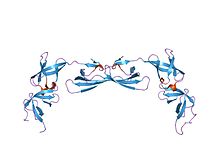Elongation factor P
| Elongation factor P (EF-P) KOW-like domain | |||||||||
|---|---|---|---|---|---|---|---|---|---|
 crystal structure of translation initiation factor 5a from pyrococcus horikoshii | |||||||||
| Identifiers | |||||||||
| Symbol | EFP_N | ||||||||
| Pfam | PF08207 | ||||||||
| Pfam clan | CL0107 | ||||||||
| InterPro | IPR013185 | ||||||||
| PROSITE | PDOC00981 | ||||||||
| |||||||||
| Elongation factor P (EF-P) OB domain | |||||||||
|---|---|---|---|---|---|---|---|---|---|
 crystal structure of translation elongation factor p from thermus thermophilus hb8 | |||||||||
| Identifiers | |||||||||
| Symbol | EFP | ||||||||
| Pfam | PF01132 | ||||||||
| Pfam clan | CL0021 | ||||||||
| InterPro | IPR001059 | ||||||||
| PROSITE | PDOC00981 | ||||||||
| CDD | cd04470 | ||||||||
| |||||||||
| Elongation factor P, C-terminal | |||||||||
|---|---|---|---|---|---|---|---|---|---|
| CDD | cd05794 | ||||||||
| |||||||||
EF-P (elongation factor P) is an essential
EF-P consists of three
- An N-terminal KOW-like domain
- A central OB domain, which forms an oligonucleotide-binding fold. It is not clear if this region is involved in binding nucleic acids[5]
- A C-terminal domain which adopts an OB-fold, with five beta-strands forming a beta-barrel in a Greek-key topology[5]
Eukaryotes and archaea lack EF-P. In these domains, a similar function is performed by the archaeo-eukaryotic initiation factor,
Function
In eubacteria, there are three groups of factors that promote protein synthesis:
To complete its function, EF-P enters paused ribosomes through the E-site and facilitates peptide bond formation through interactions with the P-site tRNA.[11] EF-P and eIF-5A both are essential for the synthesis of a subset of proteins containing proline stretches in all cells.[1]
It has been suggested that after binding of the initiator tRNA to the P/I site, it is correctly positioned to the P site by binding of EF-P to the E site.[12] Additionally, EF-P has been shown to assist in efficient translation of three or more consecutive proline residues.[13]
Structure
EF-P is a 21 kDa protein encoded by the efp gene.[9] EF-P consists of three β-barrel domains (I,II and III) and has a L shape tRNA structure. Domain II and III of EF-P are similar to each other. Despite the structural similarity of EF-P with tRNA, studies showed that EF-P does not bind to the ribosome at the classical tRNA binding site, but at the distinct position that is located between the P and E sites.[3]
See also
- Prokaryotic elongation factors
- EF-Ts (elongation factor thermo stable)
- EF-Tu (elongation factor thermo unstable)
- EF-G (elongation factor G)
- EIF5A
- Protein translation
- GTPase
